Bill 168 (Violence & Harassment in the Workplace): A
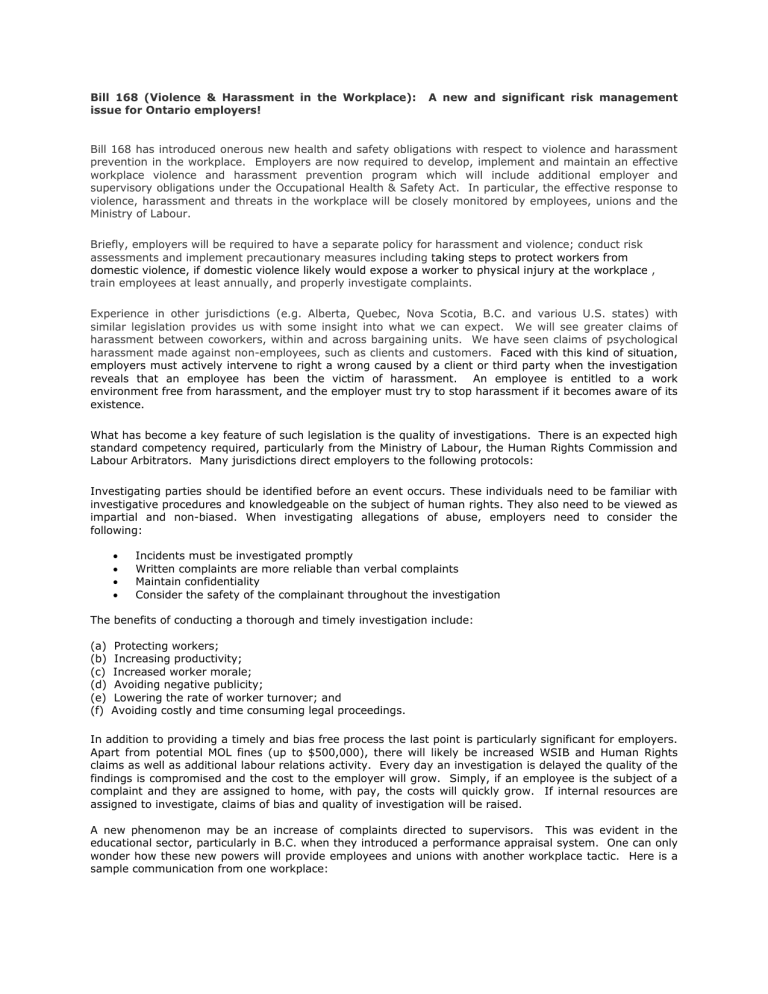
Bill 168 (Violence & Harassment in the Workplace): A new and significant risk management issue for Ontario employers!
Bill 168 has introduced onerous new health and safety obligations with respect to violence and harassment prevention in the workplace. Employers are now required to develop, implement and maintain an effective workplace violence and harassment prevention program which will include additional employer and supervisory obligations under the Occupational Health & Safety Act. In particular, the effective response to violence, harassment and threats in the workplace will be closely monitored by employees, unions and the
Ministry of Labour.
Briefly, employers will be required to have a separate policy for harassment and violence; conduct risk assessments and implement precautionary measures including taking steps to protect workers from domestic violence, if domestic violence likely would expose a worker to physical injury at the workplace , train employees at least annually, and properly investigate complaints.
Experience in other jurisdictions (e.g. Alberta, Quebec, Nova Scotia, B.C. and various U.S. states) with similar legislation provides us with some insight into what we can expect. We will see greater claims of harassment between coworkers, within and across bargaining units. We have seen claims of psychological harassment made against non-employees, such as clients and customers. Faced with this kind of situation, employers must actively intervene to right a wrong caused by a client or third party when the investigation reveals that an employee has been the victim of harassment. An employee is entitled to a work environment free from harassment, and the employer must try to stop harassment if it becomes aware of its existence.
What has become a key feature of such legislation is the quality of investigations. There is an expected high standard competency required, particularly from the Ministry of Labour, the Human Rights Commission and
Labour Arbitrators. Many jurisdictions direct employers to the following protocols:
Investigating parties should be identified before an event occurs. These individuals need to be familiar with investigative procedures and knowledgeable on the subject of human rights. They also need to be viewed as impartial and non-biased. When investigating allegations of abuse, employers need to consider the following:
Incidents must be investigated promptly
Written complaints are more reliable than verbal complaints
Maintain confidentiality
Consider the safety of the complainant throughout the investigation
The benefits of conducting a thorough and timely investigation include:
(a) Protecting workers;
(b) Increasing productivity;
(c) Increased worker morale;
(d) Avoiding negative publicity;
(e) Lowering the rate of worker turnover; and
(f) Avoiding costly and time consuming legal proceedings.
In addition to providing a timely and bias free process the last point is particularly significant for employers.
Apart from potential MOL fines (up to $500,000), there will likely be increased WSIB and Human Rights claims as well as additional labour relations activity. Every day an investigation is delayed the quality of the findings is compromised and the cost to the employer will grow. Simply, if an employee is the subject of a complaint and they are assigned to home, with pay, the costs will quickly grow. If internal resources are assigned to investigate, claims of bias and quality of investigation will be raised.
A new phenomenon may be an increase of complaints directed to supervisors. This was evident in the educational sector, particularly in B.C. when they introduced a performance appraisal system. One can only wonder how these new powers will provide employees and unions with another workplace tactic. Here is a sample communication from one workplace:
Brothers and Sisters, I realize that there are many good supervisors out there. People who can deal with the stress of their jobs without taking it out on their employees. People who represent the company fairly and treat those that work for them with respect and decency. Believe me, they are appreciated.
This letter does not concern them and I hope that they never change.
But there are too many of the other kind. Those who abuse their positions of authority and abuse our membership. The last couple of days have seen allegations of assault visited upon certain members by supervisors. This is completely intolerable. No 'ifs', 'ands' or 'buts'...no excuses...no rationalizations.
This is simply wrong and it must be dealt with. And it will be.
These allegations and the fear that many employees have about losing their jobs if they report the abuse has sparked the need to communicate to you what your rights are and to make sure you are aware that you are protected.
Often it starts with verbal harassment and too often it ends with assault. It's long overdue to stop both.
Nobody wins when you allow a bully to continue but eventually someone loses big time.
Legislation and common law establish that an employer and its agents, including employees, are liable for their actions during the course of their employment. This is often referred to as vicarious liability. The
Supreme Court of Canada, stated employers control the organization and are the only ones who can address the negative effects of harassment and violence.
Financial and legal consequences may be imposed on the employer and the supervisor, even if neither of them was involved in a situation of harassment and/or violence. However, the Supreme Court also pointed out that although employers will be liable for harassment, whether they know of it or not, the penalties imposed will be less, or non-existent for an employer that “responds quickly and effectively to a complaint … to remedy and prevent recurrence.” (Robichaud v. Treasury Board (Department of National Defence), 1987.)
Clearly, a new standard has been set in Ontario. Employers have until June 15 2010 to get organized and implement all of the components of Bill 168. Although every individual component is important the competence and speed of an investigation will be critical piece of an organization’s risk management program.
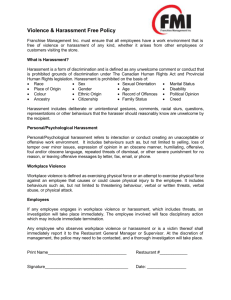
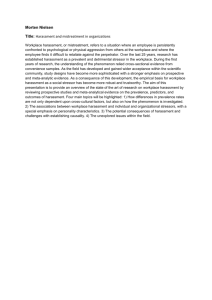

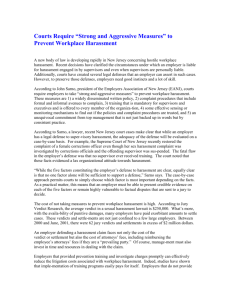
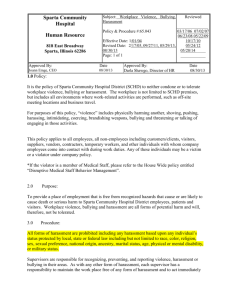
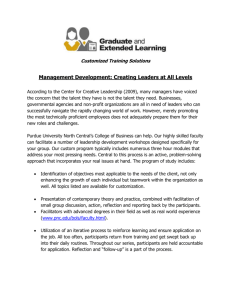
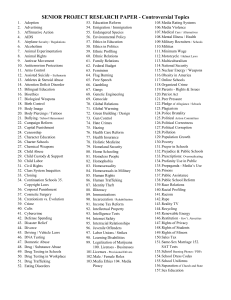


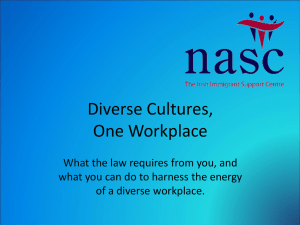

![Implementation of the ETUC[1]/BUSINESSEUROPE](http://s3.studylib.net/store/data/007557967_2-80ad411f5caf16cb34ed040647e1c615-300x300.png)